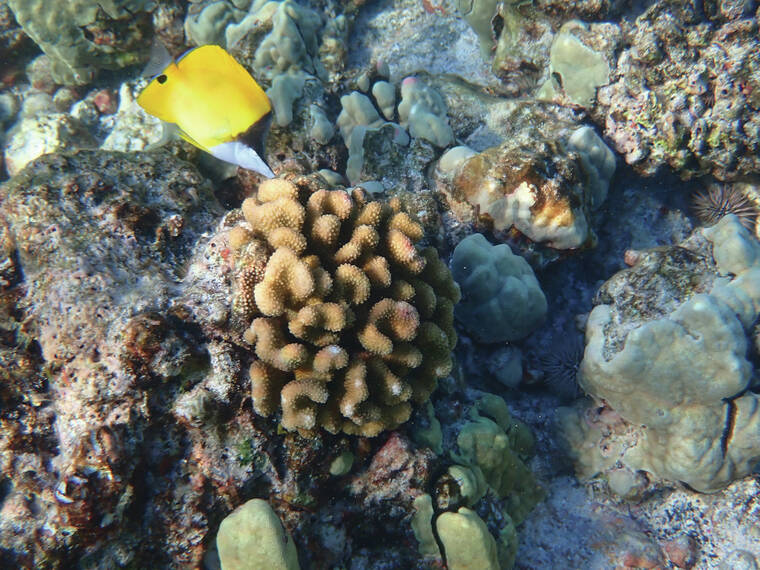$2 million insurance coverage added for island coral reefs
With the Central Pacific hurricane season underway, an insurance policy covering up to $2 million in damage to Hawaii’s coral reefs is now in effect.
The policy, the first ever in the United States, was arranged by the Nature Conservancy in a move that acknowledges the increasingly destructive potential of hurricanes and tropical storms under the influence of climate change.
The effort follows the world’s first reef insurance policy for the coastal state of Quintana Roo in Mexico and another one covering the Mesoamerican Reef off southern Mexico, Belize, Guatemala and Honduras.
Both the Mexico and Belize policies, developed by the Nature Conservancy and partners, have already led to payouts and reef repairs following hurricanes.
In Hawaii, the Nature Conservancy, along with partner agencies and nonprofits, is working to establish a set of response protocols and county-level plans, along with recruiting members for response teams in the event of a damaging hurricane.
The effort comes as forecasters predict the possibility of a busier hurricane season in Hawaii. The Central Pacific Hurricane Center is forecasting as many as seven tropical cyclones to either develop in the region or enter the neighborhood from June to November.
The Central Pacific basin, which extends from 140 degrees west to the International Date Line north of the equator, averages four to five tropical cyclones a year.
The National Oceanic and Atmospheric Administration’s Climate Prediction Center expects El Nino conditions to develop across the Pacific this summer, bringing above-average sea surface temperatures and inviting conditions for hurricane development.
The warmer waters could also lead to coral bleaching and increasingly vulnerable reefs.
In March, officials with the Nature Conservancy met over three days with representatives of project partners NOAA, the state Division of Aquatics, Kuleana Coral Restoration, Maui Ocean Center and Arizona State University’s Center for Global Discovery and Conservation based in Hilo.
Working off guidelines developed in Mexico, the group outlined the scope of a potential response that would include teams rapidly removing any debris from reefs following a strong storm and conducting coral repair work.
“We have a core set of people we are working with and who have committed to responding and who are in permits at the moment. And we definitely want to build that out,” said Makale‘a Ane, who leads community engagement and partnerships for the Nature Conservancy.
Coral reef-related tourism accounts for an estimated $1.2 billion-plus to the state’s economy, while reef fisheries generate some $13.4 million annually, much of it providing food and income for local families.
Despite the importance of reefs to the islands, overfishing and polluted runoff have contributed to a 60% decline in live coral cover on some of Hawaii’s reefs in the past 40 years, and climate change is adding more threats in the form of coral bleaching and ocean acidification.
Proceeds from the Quintana Roo policy were used to repair damage from Hurricane Delta in 2020. And the Belize policy was triggered by Hurricane Lisa in 2022, resulting in a payout and the rapid repair of the beach and reef, officials said.
In Hawaii the insurance project gained momentum after a 2020 Bank of America-supported feasibility study found that coral reefs here could indeed be insured against natural disasters, and the state Senate passed a 2021 resolution calling for further study.
The Nature Conservancy worked with Willis Tower Watson’s Climate and Resilience Hub to select the insurance firm of Munich Re to issue a policy that will be triggered at wind speeds of 57 mph and proximity to Hawaii’s main reefs.
The fact that the policy is tied to wind speeds will allow swift payouts to expediting debris removal and reef repair activities.
The policy coverage area focuses on three general reef areas: Oahu, West Hawaii and the region between Molokai, Lanai and Maui.
In addition to wind speeds, the payouts will depend on proximity to the center of the three reefs, each of which is insured for $1 million with a maximum payout of $2 million. All of the reefs around the main islands, except Niihau, will receive some kind of coverage depending on proximity to the three main reef areas.
The cost of the insurance policy is roughly $100,000, which was underwritten by private funders that included the Bank of America Charitable Foundation and Howden Group Foundation, the charitable arm of international insurance agency Howden Group Holdings.
For Ane, Hawaii’s reefs hold a special place in her heart beyond the various ecosystem services they provide to the community.
“As a Native Hawaiian, I know the importance of coral reefs for us culturally, our genealogical connection to corals through our Kumulipo (creation chant),” she said.


